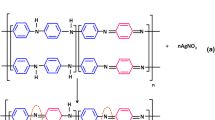Abstract
The main purpose of this work was to evaluate the effect of the silver to mercury ratio on the voltammetric responses of silver solid amalgam electrodes (AgSAE’s). For this, the AgSAE were prepared by mechanical mixing the metals in the following mass ratios of silver to mercury: 30/70, 40/60, 50/50, 60/40, and 70/30. The resulting AgSAE’s were physically characterized by energy dispersive X-ray analysis, X-ray diffraction and scanning electron microscopy, confirming the mass percentages of the silver and mercury, the total absence of liquid mercury and a globular structure of all AgSAE’s. Furthermore, it was observed that the AgSAE 30/70 contained only one single phase (Ag2Hg3), and no metallic silver or mercury oxides. Additionally, the resulting AgSAE’s were chemically characterized with respect to the influence of the electrode composition on the reproducibility and electrochemical signals of a hexamine-ruthenium (III) chloride solution by use of electrochemical impedance spectroscopy and cyclic voltammetry. The separation between anodic and cathodic peaks, and consequently, the charge transfer resistance across the electrode/solution interface, and the electroactive area were calculated demonstrating that the 30/70 composition is the best surface for practical applications. Finally, square-wave voltammetry experiments were performed in 4-nitrophenol solution, with a previous optimization of the experimental and voltammetric parameters. The calculated detection limit shows that the AgSAE 30/70 is suitable for determining any contamination by p-nitrophenol, minimizing the toxic residues in case of using liquid mercury electrodes.





Similar content being viewed by others
References
Wang J (1994) Analytical electrochemistry. VCH, USA
Barek J, Fisher J, Navrátil T, Pecková K, Yosypchuk B, Zima J (2007) Nontraditional electrode materials in environmental analysis of biologically active organic compounds. Electroanalysis 19:2003–2014
Yosypchuk B, Novotný L (2002) Cathodic stripping voltametry of cysteine using silver and copper solid amalgam electrodes. Talanta 56:971–976
Melo LC, De Souza D, Lima-Neto P, Salazar-Banda GR, Machado SAS, Correia AN (2009) A simple and sensitive detection of diquat herbicide using a dental amalgam electrode. A comparison using the chromatographic technique. Talanta 79:1216–1222
De Souza D, de Toledo RA, Galli A, Salazar-Banda GR, Silva MRC, Garbellini GS, Mazo LH, Avaca LA, Machado SAS (2007) A methodology without waste toxics for the electroanalytical determination of triazinics herbicides. A comparative study between voltammetric and chromatographic techniques. Anal Bioanal Chem 387:2245–2253
Yosypchuk B, Novotný L (2003) Copper solid amalgam electrodes. Electroanalysis 15:121–125
Dantas ANS, De Souza D, Lima JES, Lima-Neto P, Correia AN (2010) Voltammetric determination of ketoconazole using silver solid amalgam electrode. Electrochim Acta 55:9083–9089
De Souza D, Melo LC, Correia AN, Lima-Neto P, Fatibello-Filho O, Mascaro LH (2010) Utilização de eletrodos sólidos de amálgama para a determinação analítica de compostos orgânicos e inorgânicos. Quim Nova, in press
Yosypchuk B, Barek J (2009) Analytical applications of solid and paste amalgam electrodes. Crit Rev Anal Chem 39:189–203
Crystallographic Software for teaching, researching and industries (2010) United Kingdom. http://www.crystallographica.co.uk/, assessed in 19 august 2010
Scribner Association Inc.—advanced products for electrochemical researches (2010) Canadá. http://scriber.com, assessed in 19 august 2010
Garbellini GS, Salazar-Banda GR, Avaca LA (2007) Sonovoltammetric determination of 4-nitrophenol on diamond electrodes. J Braz Chem Soc 28:1095–1099
Fadrn R (2005) Polished silver solid amalgam electrode: further characterization and applications in voltammetric measurements. Anal Lett 37:3255–3270
Gosser KD Jr (1993) Cyclic voltammetry: simulation and analysis of reaction mechanisms. VCH, New York
Fry AJ (1973) Synthetic organic electrochemistry. Harper & Row, New York
Koryta J, Dvorak J, Kavan L (1993) Principles of electrochemistry, 2nd edn. Wiley, New York
Niaz A, Fisher J, Barek J, Yosypchuk B, Bhanger M (2009) Voltammetric determination of 4-nitrophenol using a novel type of silver amalgam paste electrode. Electroanalysis 21:1786–1791
Navrátil T, Barek J, Fasinová-Sebková S (2009) Differential pulse voltammetric determination of selected nitro-compounds on silver, solid silver composite, and solid graphite composite electrodes. Electroanalysis 21:309–315
Mocak J, Bond AM, Mitchel S, Scollary G (1997) A statistical overview of procedures for determining the limits of detection and quantification: application to voltammetric and stripping techniques. Pure Appl Chem 69:297–328
Analytical Methods Committee (1987) Recommendations for the definition, estimation and the use of the detection limit. Analyst 112:199–204
CONAMA—Conselho Nacional do Meio Ambiente (2010) Brasil. http://www.mma.gov.br/conama/, assessed in 19 August 2010
Garrido EM, Delerue-Matos C, Lima JLFC, Brett AMO (2004) Electrochemical methods in pesticides control. Anal Lett 37:1755–1791
Danhel A, Shiu KK, Yosypchuk B, Barek J, Peckova K, Vyskocil V (2009) The use of silver solid amalgam working electrode for determination of nitrophenols by HPLC with electrochemical detection. Electroanalysis 21:303–308
Acknowledgments
The authors would like to thank the National Council for Research—CNPq (process 150610/2007-6) for financial support.
Author information
Authors and Affiliations
Corresponding author
Rights and permissions
About this article
Cite this article
De Souza, D., Mascaro, L.H. & Fatibello-Filho, O. The effect of composition of solid silver amalgam electrodes on their electrochemical response. J Solid State Electrochem 15, 2023–2029 (2011). https://doi.org/10.1007/s10008-010-1225-3
Received:
Revised:
Accepted:
Published:
Issue Date:
DOI: https://doi.org/10.1007/s10008-010-1225-3




